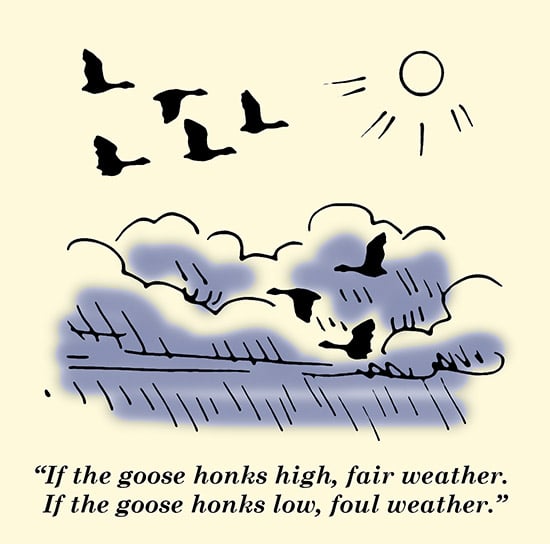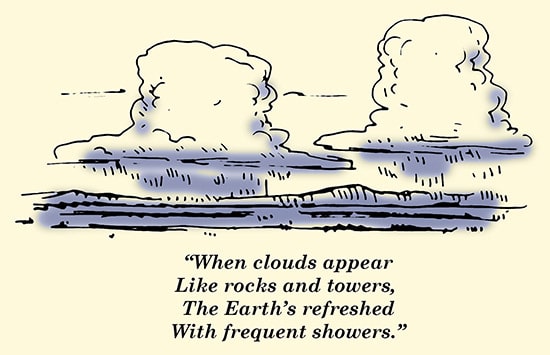When you really think about it, the weather impacts our decisions every single day. What we wear, when we leave for our morning commute, the chores we do, the hobbies we partake in, the family activities we plan. And on and on the list goes off how our lives are influenced by the winds and skies.
Today, we have meteorologists and entire government agencies dedicated to predicting the weather with high-tech computers and algorithms, but a hundred and two-hundred years ago (and more!), folks had to rely mostly on observation and rudimentary tools to predict the weather of the coming days.
To help with this task of predicting the weather, farmers, sailors, and amateur meteorologists of all kinds came up with handy, often rhyming proverbs that could guide their observations. They realized that animal behavior, wind direction, air pressure (which could be measured with a barometer), etc., were pretty accurate indicators of how the weather would behave.
Perhaps surprisingly, most of this handed-down “folk wisdom” is really quite accurate, and has a lot of science behind it; weather proverbs of old can be applied today just as well as they were centuries ago. Rather than relying on your local meteorologist or your smartphone app to tell you what to wear for the day, why not work on your powers of observation and come to understand more about the weather and the natural world around you?
Note: I highly recommend first reading our article on air pressure and barometers; many of these proverbs are related to atmospheric pressure and how it relates to incoming and outgoing weather systems.
1. “If the goose honks high, fair weather.If the goose honks low, foul weather.”

This proverb has nothing to do with the pitch of a goose’s honk, but rather the altitude of its flight. If the goose “honks high” — or is flying at high altitude, it’s an indication of high barometric pressure, and therefore good weather. If it’s flying lower in the sky, barometric pressure is low, and poor weather is foretold. This is because geese are incredibly adept at flying with optimum air density. When air pressure is high, that optimum level is high in the sky, and the reverse is true for low pressure.
 AcuRite 75077A3M Wirel...
Best Price: $31.24
Buy New $44.99
(as of 10:35 UTC - Details)
AcuRite 75077A3M Wirel...
Best Price: $31.24
Buy New $44.99
(as of 10:35 UTC - Details)
So, if geese are flying their V formations high up, get that picnic ready.
2. “When pipes smell stronger,It’s going to rain.”
To understand this proverb, we need to go to the molecular level. In dry air, aromatic or “smell” molecules (those that carry scent to our noses) are “naked” — they are floating around in the air on their own. In moist, humid air, water molecules attach to the aromatic molecules, and the scent becomes hydrated. This allows those smell molecules to better attach themselves to the moist surfaces of your nose, which makes their particular scent stronger.
When the air is moist like this, humidity is increasing, making rain more likely. So if your tobacco pipe has a stronger smell than usual, you might predict that poor weather is on its way. The same effect can be noted with lovely-smelling flowers (“Flowers smell best just before a rain”) and also offending manure fields and ponds (“Manure smells stronger before a rain” and “When ditches and ponds offend the nose, Look for rains and stormy blows”).
3. “If spiders are many and spinning their webs,The spell will soon be very dry.”

Spider webs are incredibly sensitive to moisture in the air. When humidity is high, their webs can absorb that water, making them heavy to the point of sometimes even breaking. Spiders are aware of this, so when they sense high humidity, they are most apt to stay in their hiding places. For humans, this is a sign that rain/poor weather is on its way. When they sense dry air (a sign of good weather), they’ll come out and spin their webs freely, knowing they have a few days of happy hunting.
4. “Red sky at night,Sailor’s delight;Red sky in morning,Sailor’s warning.”
While this weather proverb (and its many variants) is probably the most well known in our culture, its truth is a little more complicated than is typically understood. This is because the proverb isn’t actually specific enough for us to accurately predict the weather.
A red sky at night can indeed mean fair weather, but particularly if the red appears in the eastern sky. A red night sky in the east likely means that the light of the setting sun is passing through the low atmosphere and reflecting off clouds. If this is the case, it’s possible that rain has already passed, and you’re in the clear.
A red western sky at night can mean a couple things, depending on the shade of red. A more pinkish hue can portend clear, fair weather, but a deep red sky at night to the west can mean that moisture is collecting in the air, and a storm system is forming.
The “red sky in morning” half of the proverb can be equally vexing.
Beyond just the atmospheric explanations, pollution and other unnatural particles in the air can drastically affect the color of the sky in all directions and all times of the day.
So while you’ll find quick answers and explanations to the proverb online, a red sky can ultimately mean different things based on a variety of factors, both natural and not-so-natural. While it’s a quippy proverb, the others on this list will better help you predict the weather in the coming days.
5. “When dew is on the grass,Rain will never come to pass.”
Dew forms when the grass gets colder than the dewpoint temperature (the temp at which dew forms). At night, grass cools when heat from the ground radiates upward. In a clear, dry atmosphere, this heat escapes the atmosphere and rises into outer space.
In a moist and humid atmosphere, water vapor absorbs some of that heat and can redirect it back down to the ground, warming up the grass, and thus keeping it dew free.
Dew on the grass is, therefore, a sign of a high-pressure system, and good weather.
6. “Doors and drawers stick before a rain.”
Doors that stick in the frame upon opening or that are troublesome to close are indicators of high humidity, portending rain. There is a lengthy biological — specifically dendrological (the study of trees) — explanation for this, but for our purposes, just know that wood expands when the air humidifies. Humidity is a sign of low pressure and incoming poor weather, so when doors stick, look for showers.
7. “Frogs croaking in the lagoon,Means rain will come real soon.”
As cold-blooded amphibians, frogs require moist skin and relatively high temperatures to be active. This means that their croaking implies that both temps and humidity are high (the water in the air keeps their skin moist). High humidity, as we’ve learned, is a sign of incoming rain.
8. “When clouds appearLike rocks and towers,The Earth’s refreshedWith frequent showers.”

This proverb references the foreboding visual characteristics of storm clouds — known as cumulonimbus clouds. These towering behemoths reach up to 75,000 feet in the sky, and before turning anvil-like, they appear as rocks being stacked upon each other. So when rocks and towers appear in the sky, expect storms.
9. “Mackerel skies and mares’ tailsMake tall ships carry low sails.”
 National Geographic Ki...
Best Price: $1.99
Buy New $8.58
(as of 04:30 UTC - Details)
National Geographic Ki...
Best Price: $1.99
Buy New $8.58
(as of 04:30 UTC - Details)
“Mackerel” in this proverb is referring to altocumulus clouds while “mares’ tails” is referring to cirrus clouds. Seeing these in the sky can mean a low-pressure system is coming. In the immediate future (24 hours or so), you’ll see the good weather. But the mackerels and mares’ tails are the first visible signs of an approaching warm front, which provides the ingredients for storms. As the system rolls in, the clouds will become thicker and thicker until the rain starts to fall.
So when a ship would see these signs, they’d lower the sails and batten down the hatches in preparation of incoming bad weather.
10. “A ring around the sun or moon,Means that rain will come real soon.”
A ring around the sun or moon is caused by light from those bodies (light doesn’t come from the moon, but you get my drift…) passing through ice crystals in the upper atmosphere. These ice crystals have either been blown over the tops of high, approaching storm clouds, or from high cirrus clouds, which as we just learned, can be the first indication of an incoming low-pressure system. So when you see a ring, prepare for precipitation.





